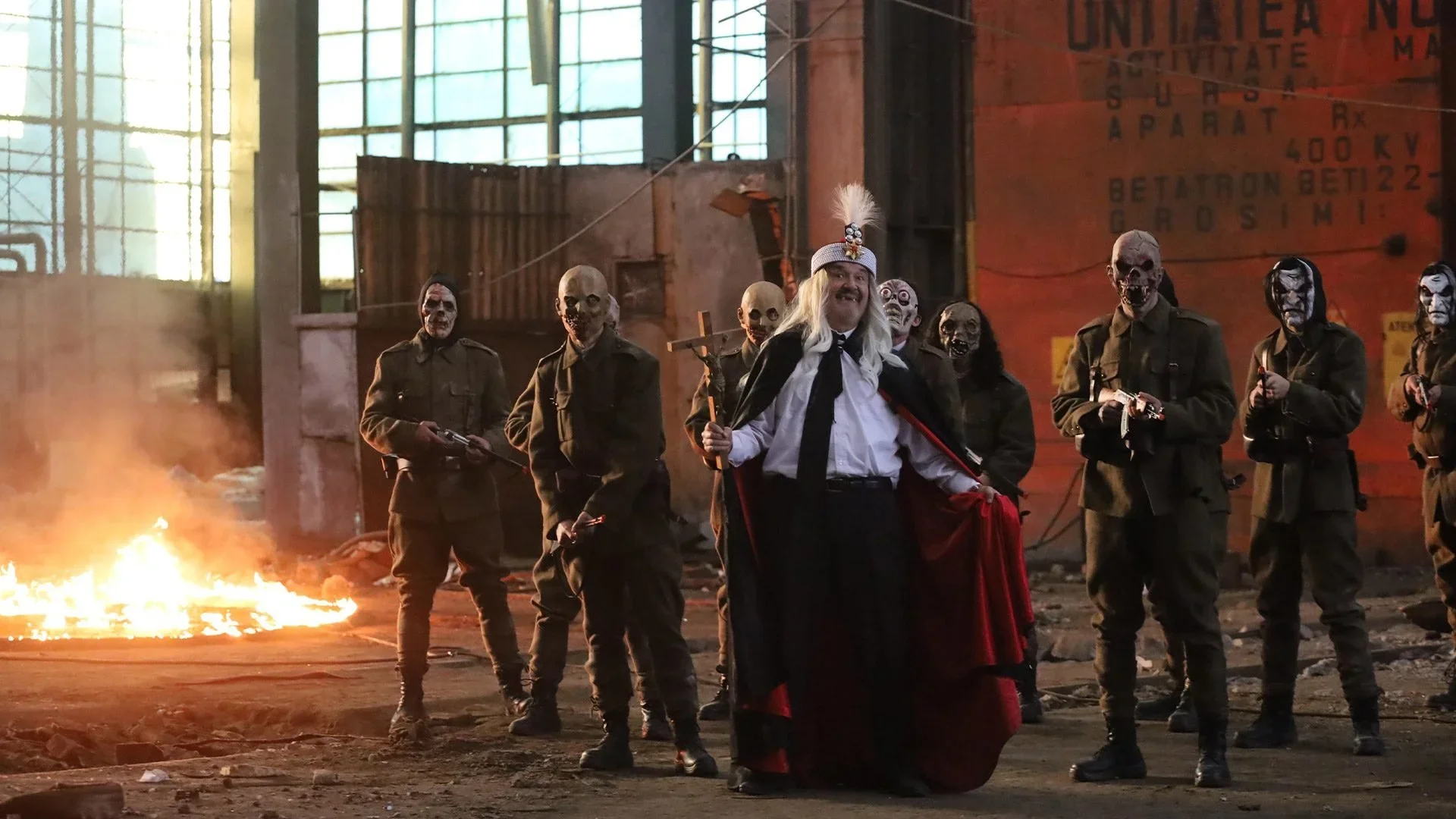VIFF 2025: ‘Dracula’ Review
A leading example of vulgar auteurism, Radu Jude continues to skewer modern-day technology with an unflinching gaze into the abyss. This time, Jude’s examination of technology’s intersection with societal degradation finds the Romanian director navigating the rise of artificial intelligence in both storytelling and image generation. His latest film, Dracula, uses one of the most prolific pieces of fiction to explore Transylvania’s past, the proliferation of AI usage, and the commercialization of art in an expansive, unwieldy anthology film. Overflowing with ideas filtered through Jude’s particular brand of raunchy humour and edgy satire, Dracula is a fascinating experiment that exhausts its point on technology’s place in art by bluntly confronting it with varied effectiveness.
The perfect litmus test on whether Jude’s latest film will be palatable to an audience is placed right at the beginning as Jude bombards the audience with a series of AI-generated versions of Vlad the Impaler, stating, “I am Vlad the Impaler Dracula, you can all suck my cock.” The controversial use of AI in art is perhaps the most widely discussed issue at present, especially with AI-generated actors now taking center stage. Even just a hint of AI can result in massive backlash from audiences and Hollywood as creatives and corporations try to negotiate an understanding of how this technology should be employed. Dracula takes these concerns and runs with them in a film that centers on a director (played by Adonis Tanța) who has run out of ideas on how to adapt Dracula without sacrificing commercial success in Hollywood. He turns to an AI program called Dr. AI JUDEX 0.0, which helps generate stories that conflate Vlad the Impaler and Dracula into a single entity, while being “the bomb,” as the director requests.
It’s clear from the initial story created by the AI program that Dracula is going to be a messy experience. The unnamed director’s film revolves around a Dracula-themed restaurant where actors flee from a crowd willing to pay to hunt real vampires. Interjected throughout are additional prompts intended to flesh out the Dracula myth, while also providing entertaining genre hybrids and adaptations of other works of art to maintain mainstream appeal. Most of it devolves into phallic imagery, accompanied by rough sketches of Romanian history and civil unrest. Jude’s screenplay pokes fun at the imprecise nature of AI, and each misunderstood prompt that the program provides works only because it’s provided meaning by the director. AI-generated images continue to flash throughout the film-within-a-film, but they’re sporadic and brief—and perhaps more importantly, they’re atrocious.
There’s a lot to be said about using AI in a film, even if it is to condemn it. It’s like smoking a cigarette to show you what it can do to you, but the problem is that it can be a double-edged sword. Those waiting to see what AI has the potential to do might look at Jude’s film and celebrate its integration of AI, even if it is crudely implemented and unappealing. One man’s trash is another man’s treasure, after all. There have been numerous botched attempts at approximating prompts and an apparent misunderstanding of what art is; AI, as a tool, is easily abused and devolves into ugly images that replicate the same commercialization of art that has existed for decades. The director, at one point, flat-out asks for a reinterpretation of Francis Ford Coppola’s Bram Stoker’s Dracula that is more erotic, and it just becomes an abomination of AI-generated photos of explicit sex between increasingly grotesque interpretations of the human body. An early short vignette, asking for something more artsy, features Dr. AI JUDEX 0.0 creating commercials for penis enlargement pills, utilizing F.W. Murnau’s Nosferatu in a similar manner to how music with an entirely different meaning can be reappropriated to sell cars or other consumer goods.
The problem with Jude’s approach is not that it is crude or confrontational, but that it makes its point quite clear early on, and then every subsequent point, revolving around Dracula, Romania, contemporary society, or repeated history, feels like a half-baked idea barely strung together by its framing device. There’s also a little too much usage of AI, even if they are brief. For a film that clocks in at almost three hours, it’s surprising that the short amount of AI-generated images used still feels like it comprises significantly more of the movie than it does. There are also large swaths of the film that are, quite frankly, boring. Jude does his best to interject humorous moments within, but the film can sometimes feel scattershot, even if it all branches off from the same source material. Ambitious in its purpose and appropriately aggressive in its approach, a stronger film lies within Jude’s grotesque dissection of AI. However, Dracula still manages to raise salient points while offering an impressive argument against the technology it critiques.
The 44th Vancouver International Film Festival takes place from October 2nd to 12th. Dracula celebrates its Canadian premiere on October 2nd, as part of VIFF’s Altered States program. The full list of films selected for the festival can be found here.


